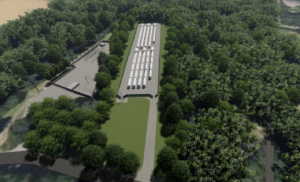See below for a representative site plan.
All battery enclosures will be a minimum of 75 feet from the property lines with the closest residence over 200 feet away. In addition to the battery enclosures, the project will also include equipment similar to what you would find in a substation: inverters, transformers, electric wires and poles, small buildings for communications equipment, etc.
Also, there will be climate control equipment integrated into the containers similar to the HVAC systems you would find in a home or business. Surrounding the project there will be fencing for security purposes and whatever additional screenings the County Board may require.



